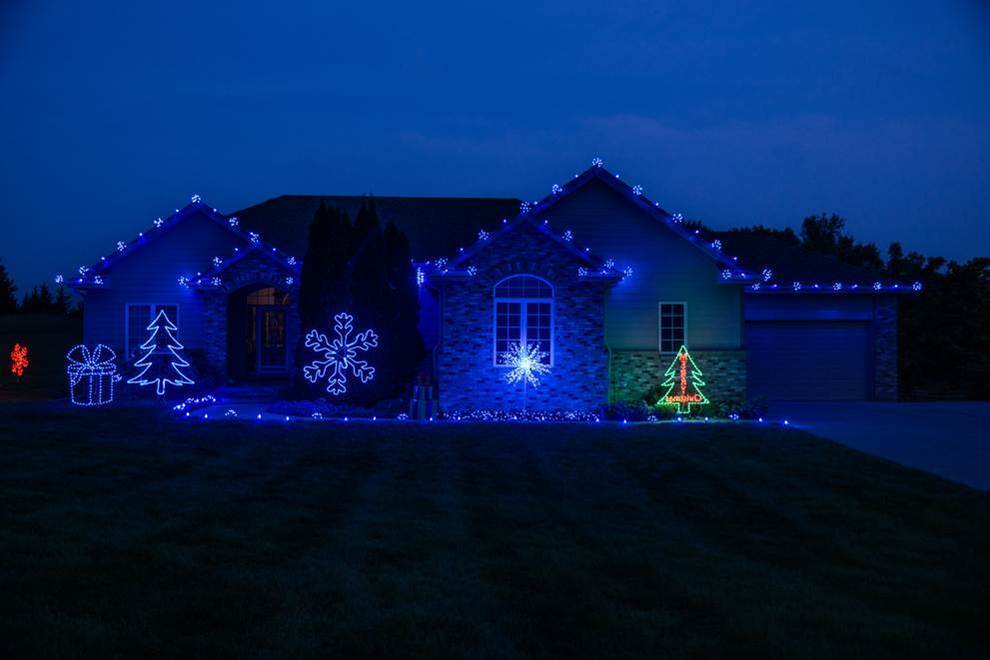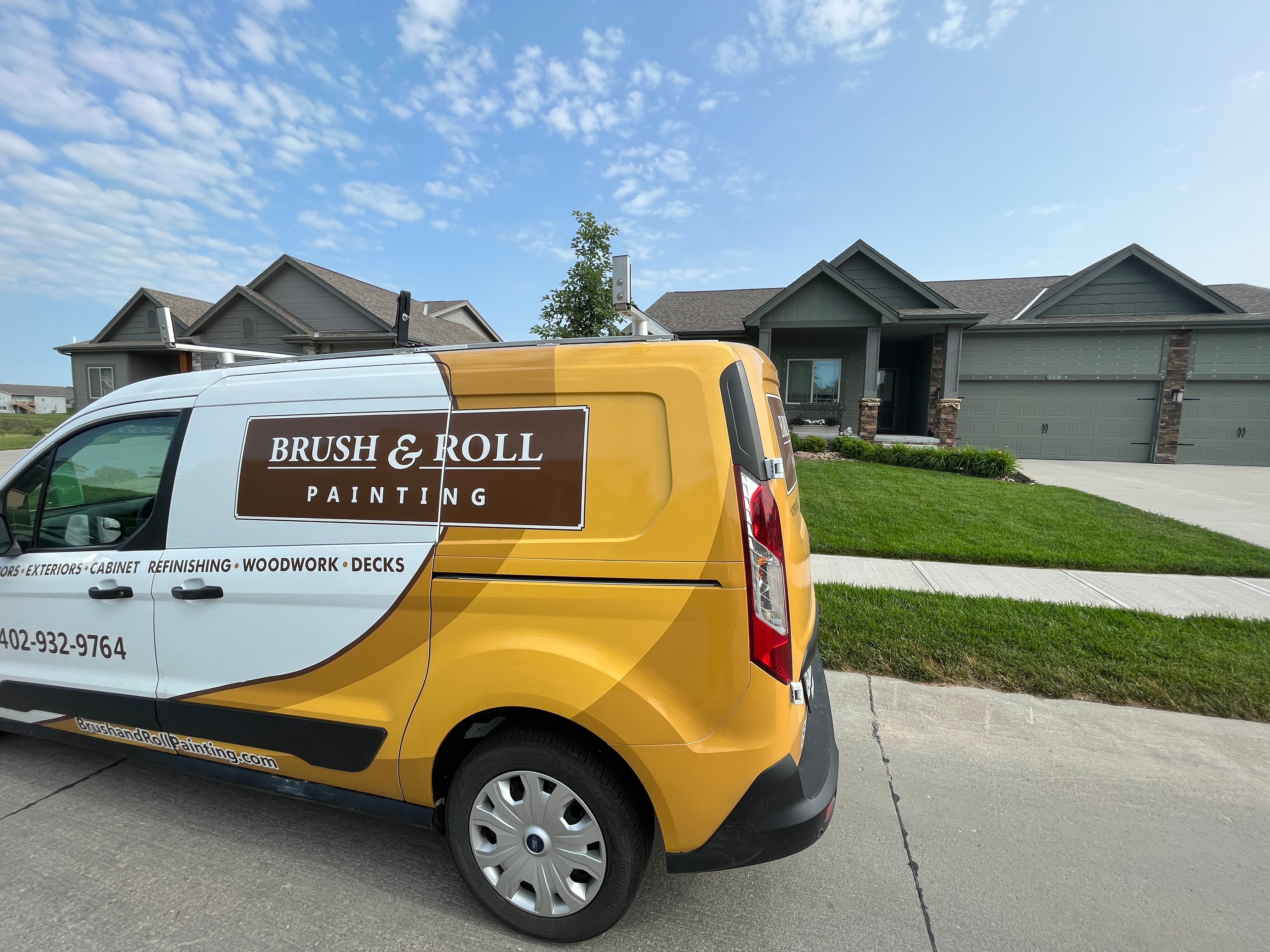Interior Paint Comparison: Benjamin Moore vs Sherwin Williams
June 19th, 2023
6 min read

Are you planning to paint the interior of your home and wondering which brand of paint to choose? With so many options on the market, it can be overwhelming to make a decision. Two of the most popular brands are Benjamin Moore and Sherwin Williams.
At Brush & Roll Painting in Omaha, NE, we take pride in using high-quality and durable paint products. While our personal preference is to use Benjamin Moore, we have extensive experience in Sherwin-Williams paints as well.
In this article, we will compare these two brands based on different factors such as quality, cost, color selection, and customer satisfaction. This article will help you better prepare for an interior painting project and may help you find the best paint for your next interior painting project.
Click here to watch a video of Owner and Operator of Brush & Roll Painting going through the differences between low vs high quality paint and Sherwin Williams and Benjamin Moore.
Benjamin Moore vs Sherwin Williams Interior Paint Quality Comparison
When it comes to painting the interior of your home, choosing the right paint is crucial. Benjamin Moore and Sherwin Williams are two of the most popular brands of paint on the market today. But which one is better? Let's take a closer look at each brand to help you decide which one is right for you.
Each brand has a range of low to high-quality paint. So you can be aware of all the possibilities of low to high-quality paint, we have included contractor-grade paint options. If you are comparing painting quotes, find out which paint each company uses, and use this guide to distinguish them.
When it comes to quality, both Benjamin Moore and Sherwin Williams offer high-quality interior paints. Both brands are known for their excellent coverage, durability, and finish. However, Benjamin Moore is often recognized as having a slightly better quality than Sherwin Williams.
Benjamin Moore paints tend to have better coverage with fewer coats needed to achieve the desired finish.
Benjamin Moore vs Sherwin Williams Interior Paint Features
Paint Durability
Durable paint will prove itself over time by maintaining its color and resisting damage. This is one of the best qualities you can get in any product, especially paint products. It proves that you are getting your money's worth as the product is lasting as long as possible.
Paint Clean-ability
The paint must be easy to clean. Nobody wants stains that won’t budge or color that rubs off with the grime. High-quality durable paint will be easy to clean, making maintaining that beautiful finish a breeze.
Paint VOCs (Volatile Organic Compounds)
VOCs are chemicals used in solvents in paint. Their main purpose is to act as a medium while transferring paint in a can to its intended surface. These have high vapor pressure and low water solubility.
While paints have safe levels of VOC, as it's regulated by the federal government, they can be harmful when breathed in large amounts. The cap is 250 grams per liter for flat finishes and 380 g/l for other finishes (like semi-gloss).
The Minnesota Department of Health says, “once these chemicals are in our homes, they are released or “off-gas” into the indoor air we breathe. They may or may not be able to be smelled, and smelling is not a good indicator of health risk.”
Many paint companies make low VOC paint or zero-VOC paints. Low VOC paint, or LVOC for short, contains 50 g/l or less of this chemical. These paints can still be low or high quality, depending on the other ingredients. However, low-quality paints are typically made with more solvents, so they likely have more VOC levels.
Low VOC and zero VOC paints are environmentally friendly as there are fewer harmful chemicals in the paint.
Paint Coverage
The paint coverage is important to know you are getting the best price. The greater the square footage, the more the paint will cover the surface, meaning you don't need to buy as much paint.
-May-16-2024-09-28-19-6344-PM.png?width=570&height=298&name=Blog%20Post%20Image%20Size%20(2)-May-16-2024-09-28-19-6344-PM.png)
The Volume of Solids in Paint
Solids are one of the main components of paint. After the paint is applied and begins to dry, the solvent evaporates and leaves behind the pigment and resin, which becomes the solids. You want to look for a range of 35-50% in the number of solids in your paint.
The higher that number, the more durable the paint will be. The thicker it applies, and the more coverage it gives. The lower percentage of these solids in paint does the opposite, it is thin, has poor hiding, and leaves you with low durability.
Mildew Resistance in Paint
Mildew resistance is an additive in paint. High humidity can cause mildew or mold on paint. With this additive, paints can fight against bacteria growth and protect you from a messy situation.
Primer Included in Paint
A primer included in the paint tells you that the paint can adhere well to surfaces. The number one job of a primer is to adhere to the original wall or old paint easily while allowing for another coat to be applied smoothly. Primer also helps sure the best color pays off as well as an extra layer of durability.
Cost of Benjamin Moore vs Sherwin Williams Interior Paint
One of the most significant factors that people consider when choosing a brand of paint is cost. Both Benjamin Moore and Sherwin Williams offer a range of paints at different price points. Benjamin Moore tends to be slightly more expensive than Sherwin Williams, with their premium paints costing significantly more. However, Benjamin Moore's paints tend to last longer and require fewer coats, which can save you money in the long run.
The cost per gallon of each paint is a good telling sign of how durable the paint is. As you can see, the higher the number of solids, the more durable, great clean-ability, and great coverage will result in a higher price.
Remember while comparing costs in terms of paint, you get what you pay for.
Color Selection of Benjamin Moore vs Sherwin Williams Interior Paint

Choosing the right color for your interior paint can make a significant impact on the overall look and feel of your home.
Benjamin Moore has a slight edge in terms of color selection, offering over 3,500 options. Their color options tend to be more consistent and have better color accuracy, which can be especially important when trying to match colors from different rooms.
Sherwin-Williams has about 1,700 color options available.
Technology of Benjamin Moore vs Sherwin Williams Interior Paint
Both Benjamin Moore and Sherwin Williams have exclusive technology, usually found in their higher-quality products. Both of the brands have developed stain-blocking technology that allows the paint to be scrubbed without any color rubbing off.
Benjamin Moore's groundbreaking technology, Gennex Color Technology, and Color Lock Technology, both focus on maintaining a deep and accurate pigment. The Gennex Color technology eliminates the chemicals that cause dark colors to weaken paint. Color Lock, permanently binds the pigments to the resin, resulting in fade resistance.
Across its product line, Sherwin-Williams has developed several technology features.
- Ceramic Microspheres - These are tiny ceramic beads that are added to the paint formula to improve durability, resist cracking, and improve insulation.
- Proprietary Resin Technology - This technology provides better adhesion and resistance to stains, making the paint more durable and long-lasting.
- Anti-Microbial Technology - This technology helps prevent the growth of mold and mildew on painted surfaces, making it ideal for use in humid environments.
- Self-Cleaning Technology - Some Sherwin-Williams paints feature a self-cleaning technology that helps keep painted surfaces clean by reducing the buildup of dirt and grime.
Eco Friendliness of Benjamin Moore vs Sherwin Williams Interior Paint
Both brands have taken strides to include environmentally safe options for their paint. Each brand carries an exclusion Eco option that is not mentioned above.
Benjamin Moore takes the cake for having the most environmentally friendly paint options as almost all of their products have zero VOCs.
Customer Satisfaction of Benjamin Moore vs Sherwin Williams Interior Paint
Finally, when it comes to customer satisfaction, both Benjamin Moore and Sherwin Williams have high ratings. Benjamin Moore is known for its exceptional customer service, which includes in-store consultations and color-matching services. Sherwin-Williams, on the other hand, offers a loyalty program that allows customers to earn rewards for their purchases. Both brands also offer online reviews and ratings, which can provide valuable insight into the quality and performance of their paints.
In our comparison chart, we have included the clean-ability of each product. We know this is an important feature in paint that can get overlooked, but helps when you have an unexpected stain. The more high-quality colors are easiest to clean, providing better customer satisfaction.
Benjamin Moore vs Sherwin Williams Interior Paint
In conclusion, both Benjamin Moore and Sherwin Williams offer high-quality interior paints, but each has its unique strengths. Benjamin Moore is known for its superior quality and color accuracy, while Sherwin Williams is often more affordable and offers a loyalty program.
When choosing between the two brands, it's important to consider your specific needs, including your budget, color preferences, and desired finish. Ultimately, the best choice is the one that meets your needs and expectations.
We hope this comparison has helped you make an informed decision and feel confident in your choice of paint brand for your next interior painting project whether you are doing it yourself or hiring a professional painting contractor.
If you are looking to hire in Omaha, NE, consider Brush & Roll Painting. Our work involves detailed prep and using our skills and experience with high-quality products. Schedule a free estimate with us now.
Next, check out our Guide to Interior Painting so you can be best prepared for your upcoming interior painting project.
To stay confident through each step of the process, get your free interior painting project checklist below.
Kaylea is the Brush & Roll Painting Content Manager. Kaylea is a Journalism and Media Communications summa cum laude graduate with a minor in Marketing from the University of Nebraska at Omaha. Kaylea manages the marketing for Brush & Roll Painting.




















-Jul-23-2025-02-21-33-5468-PM.png?width=800&height=418&name=Blog%20Post%20Image%20Size%20(2)-Jul-23-2025-02-21-33-5468-PM.png)




-Oct-22-2025-01-39-19-5208-PM.png?width=800&height=418&name=Blog%20Post%20Image%20Size%20(1)-Oct-22-2025-01-39-19-5208-PM.png)


